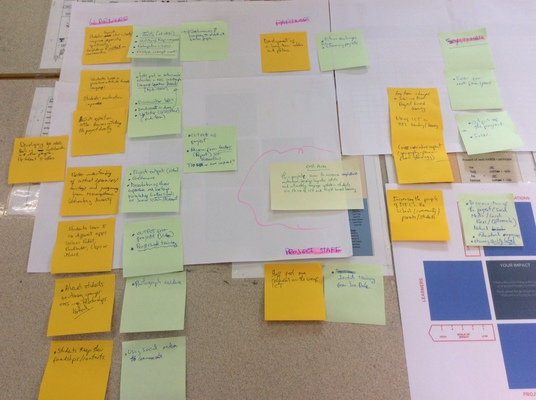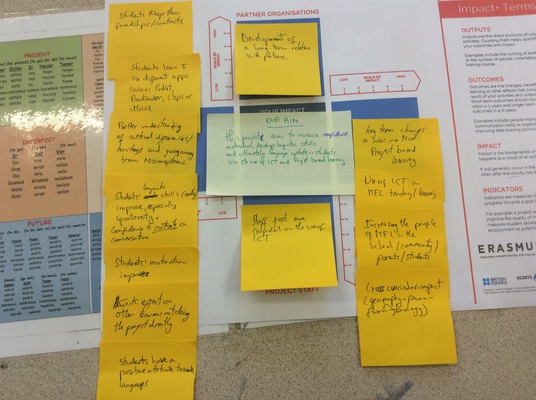See below a summary of all virtual activities to be carried out before of after our mobilities
01 Preliminary activities.docx
Logo Activity
After selecting students to take part in project, students, in pairs or groups of threes design a logo which represents our project: “United in Diversity”. All designs/drawings will need to be uploaded into our Project Page under each school Logo Contest page. All students and teachers then will vote for one logo from the final three. Schools cannot vote for the Logo that represents their country.
Who are we? Activity
Live session with etwinning where students will introduce themselves. Students will talk to the partners from the country they will be working with and will speak in a mixture of target language and Mother Tongue.
- 2 minutes interventation per student.
- 18 students from Kings to talk to 18 students from Andrés Vandelvira.
- 8 studens from Kings to talk to 15 students from College Chaloupe Saint Leu.
Teachers will arrange a convenient time for the live session to take place and will need to try the system first.
Students can also prepare questions in the Target Language/ Mother Tongue to their partners.
As a language follow up activity, students can write a summary of what they hear.
Impact + Exercise
To carry out the Impact + Exercise by teachers. The idea is to use the tool to establish how desired outcomes (our project objectives) will be measured throughout the project: tests, survey, specific learning activity/product, use of TL by students etc…The tool documents are available in the Project Google Drive space.

Impact + Exercise discussion of ideas photos


Inititial Survey to Students
To be done by each school individually and based on the outcomes and discussions from the Impact + exercise, although we can share ideas/documents to measure students’ linguistic and ICT knowledge and cultural awareness prior to project. The ideas is to have a second survey at the end to demonstrate impact.

What makes us British/French/Spanish Activity
Students will require the brainstorming and research of the following concepts:
- Our traditions/ festivals and how these link to religion
- Key historical/ geographical events
- Language and its historiy/etymology
- The role of music and dancing
- The role of immigration in our country and how it has shaped us.
This is to be conducted in TL .
After research, students can interview members of their community to find out more. students will show their ideas via a presentation. Students use TL. Students/ schools may choose from: Google slides/ Clips/ P rezzi / any other app which will allow interactivity of videos, photos etc.. Students may work in pairs or small groups. Final presentaions will be inserted in our eTwinning page.
Let's see each others' presentations Activity
Students will see each presentations, one or two per country and will reflect on these, which will lead to discussions in the TL or own language:
- What is different in the heritage seen in partner’s presentations and ours and what is the same?
- Why is different good?
- What is a stereotype?
- Why stereotypes can be negative?
Students will also have the opportunity to carry out these presenations live when they UK kids visit Spain and La Reunion and here the presentations from their Spanish and French hosts.
What makes who I am? Activity
Each student will identify a dance, a costume, festival, object, monument, historical event or a selection of these within their country of origin and explain why it is important to them and how it has shaped their identity. To be done in the TL and to use Padlet to share information, all three countries will work collaboratively on this Padlet. The Padlet will enable students to see each other's entries, to discuss what they have in common and develop a desire to be enquisitive and try to find out more about a particular festival, object etc.. as Padlets allow students to make comments!
Welcome to Europe! Activity
Students from all three countries will work on a collaborative Prezi where they will present a Tourist Guide, based on iconic cities from La Réunion, Spain or the UK. Students will work in pairs or groups of three with their partner students, online, each participant will work in the TL, to develop their linguistic skills. Spanish and French students will work with their English partners. English students learning French will work in French and those learning Spanish will work in Spanish.
Welcome to Europe will be divided into: Welcome to La Réunion, Welcome to Spain and Benvenu a La Grande Bretagne/ Bienvenido a Gran Bretana. Students from each country will work collobaratively with their partner student on two sections of the Padlet: a city from their own country and one from their host one.
For each city students must give as much information as possible: what to visit, list of activities to do, a traditional festival linked to that country, history of the festival, what it consists of, why it is worth seeing, history of the city, accommodation etc.. They may include videos and photos.
Ech pair / group of students will need to communicate via social media (WhatsApp) on how best to approach the information they find. Each student will need to find information/ work on their host country and the information obtained will need to be communicated and agreed with their host partner at all times.
As a result, and after having completed two mobilities, students will have the opportuniy to work collaboraively online wih their partner friends. The final product will be a tourist guide about the three countries in Europe created by all students celebrating the diverse heritage of Europe while allowing students to understand and reflect on each other's costums and traditions.
LIST OF OF CITIES TO WORK ON FOR EACH PAIR OF STUDENTS
08 WELCOME TO EUROPE PREZI Activity.docx